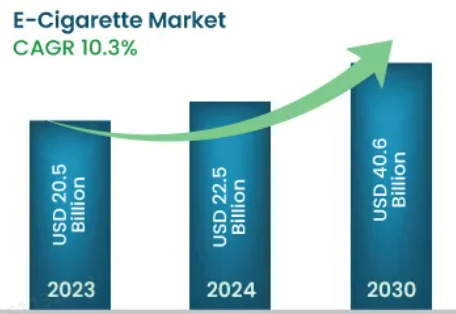The vaping industry has experienced tremendous growth and transformation over the past decade, evolving from a niche market to a global phenomenon. As we stand in 2025, the landscape of vaping continues to shift, driven by advancements in technology, changing regulations, and increasing consumer awareness. In this post, we’ll explore the current state of the vaping industry, the innovations shaping its future, and how enthusiasts and stakeholders can navigate this dynamic environment. ![]()
1. The Current State of the Vaping Industry 
The vaping market has matured significantly since its inception, offering a diverse range of devices, flavors, and nicotine strengths to cater to a wide array of preferences. According to recent industry reports, the global vaping market is projected to surpass $70 billion in annual revenue by 2025, fueled by both existing users and a growing number of smokers transitioning to less harmful alternatives.
However, this growth comes amidst increasing scrutiny. Governments and regulatory bodies worldwide are implementing stricter guidelines to ensure product safety and limit access to underage users. While these measures are critical for public health, they also pose challenges for manufacturers and consumers alike. ![]()
As responsible members of the vaping community, it’s vital to stay informed about these regulations, advocate for science-based policies, and support ethical practices within the industry. ![]()
2. Innovations Driving the Future of Vaping 

One of the most exciting aspects of the vaping industry is its relentless pursuit of innovation. Here are some key trends and advancements shaping the future of vaping:
- Temperature Control and Precision Vaping
 : Modern devices now feature advanced chipset technology, allowing users to fine-tune temperature settings for a more consistent and flavorful experience. This not only enhances satisfaction but also reduces the risk of overheating e-liquids, which can produce harmful byproducts.
: Modern devices now feature advanced chipset technology, allowing users to fine-tune temperature settings for a more consistent and flavorful experience. This not only enhances satisfaction but also reduces the risk of overheating e-liquids, which can produce harmful byproducts. - Nicotine Salt E-Liquids
 : The rise of nicotine salts has revolutionized vaping for former smokers, offering a smoother throat hit and faster nicotine absorption compared to traditional freebase nicotine. This development has made vaping a more viable alternative for those seeking to quit smoking.
: The rise of nicotine salts has revolutionized vaping for former smokers, offering a smoother throat hit and faster nicotine absorption compared to traditional freebase nicotine. This development has made vaping a more viable alternative for those seeking to quit smoking. - Pod Systems and Portability
 : Compact pod systems continue to dominate the market due to their convenience, ease of use, and discreet design. These devices are particularly appealing to new vapers and those who prioritize simplicity.
: Compact pod systems continue to dominate the market due to their convenience, ease of use, and discreet design. These devices are particularly appealing to new vapers and those who prioritize simplicity. - Sustainability and Eco-Friendly Practices
 : As environmental concerns grow, manufacturers are exploring sustainable materials and recyclable components for devices and packaging. This shift reflects a broader commitment to reducing the industry’s ecological footprint.
: As environmental concerns grow, manufacturers are exploring sustainable materials and recyclable components for devices and packaging. This shift reflects a broader commitment to reducing the industry’s ecological footprint. - Synthetic Nicotine
 : The emergence of lab-created nicotine is reshaping the regulatory landscape. Because it’s not derived from tobacco, synthetic nicotine products have sparked debates over classification and taxation, potentially influencing the industry’s trajectory.
: The emergence of lab-created nicotine is reshaping the regulatory landscape. Because it’s not derived from tobacco, synthetic nicotine products have sparked debates over classification and taxation, potentially influencing the industry’s trajectory.
3. Challenges and Opportunities 
While the vaping industry is brimming with potential, it also faces significant challenges. Public perception remains a key hurdle, as misinformation and sensationalized media coverage often overshadow the harm-reduction benefits of vaping compared to smoking.
Additionally, the rise of counterfeit products and substandard e-liquids poses a risk to consumer safety. As vapers, we must prioritize purchasing from reputable brands and retailers to ensure quality and authenticity. ![]()
On the flip side, these challenges present opportunities for innovation and advocacy. By fostering collaboration between manufacturers, researchers, and policymakers, we can create a more transparent and sustainable future for the industry. ![]()
4. Building a Stronger Vaping Community 

At the heart of the vaping movement is its passionate and diverse community. Forums like this one are invaluable platforms for sharing knowledge, discussing trends, and supporting one another on our vaping journeys. ![]() As we look to the future, let’s continue to uphold the values that make this community strong: inclusivity, education, and responsible advocacy.
As we look to the future, let’s continue to uphold the values that make this community strong: inclusivity, education, and responsible advocacy. ![]()
Whether you’re a seasoned vaper, a curious newcomer, or an industry professional, your voice matters. Together, we can shape the future of vaping and ensure that it remains a viable and innovative harm-reduction tool for years to come. ![]()
Conclusion 
The vaping industry is at a pivotal moment, balancing rapid innovation with the challenges of regulation and public perception. As enthusiasts and advocates, we play a crucial role in steering the industry toward a brighter future. By staying informed, supporting ethical practices, and fostering a sense of community, we can ensure that vaping continues to evolve as a safer and more sustainable alternative to smoking. ![]()
Let’s hear your thoughts! ![]() What trends or challenges do you think will define the vaping industry in the coming years? Share your insights and let’s spark a meaningful discussion.
What trends or challenges do you think will define the vaping industry in the coming years? Share your insights and let’s spark a meaningful discussion. ![]()
Happy vaping, and stay safe! ![]()



